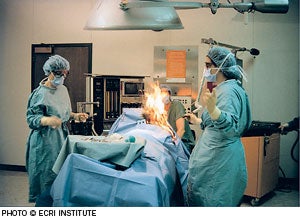Initiative helps prevent fires in the surgical suite
 |
| Re-creation of a serious fire during head and neck surgery. |
Surgical teams at Christiana Care Health System in Wilmington, Del., go through the same type of universal protocols that other hospitals employ by confirming that the correct patient is on the table for the correct procedure at the right time. But there's one notable difference. A surgical fire risk-assessment score is assigned to each case.
This shift was an outgrowth of soul-searching after two surgical fires occurred within eight months of each other at Christiana Care in 2003, says Kenneth L. Silverstein, M.D., chair of the department of anesthesiology and medical director of perioperative services.
Silverstein explained his institution's enhanced protocols during the Food and Drug Administration's October launch of a surgical fire prevention initiative. The effort, launched with the help of the American Society for Healthcare Engineering and several other partners, is aimed at raising awareness about the fire risks associated with surgical procedures performed in the oxygen-rich, operating room environment while providing hospitals with resources to reduce surgical fires.
Mark Bruley, the ECRI Institute's vice president of accident and forensic investigation, says surgical fires are rare, but when serious fires occur, the results can be devastating.
A 35-year veteran of investigating surgical fires, Bruley believes a cultural change, like the one that occurred at Christiana Care, is needed in surgical suites across the country. Everyone on the surgical team should have authority to speak up about potential fire threats they observe, he says.
For surgical fire prevention tools, log on to www.fda.gov/preventingsurgicalfires.




